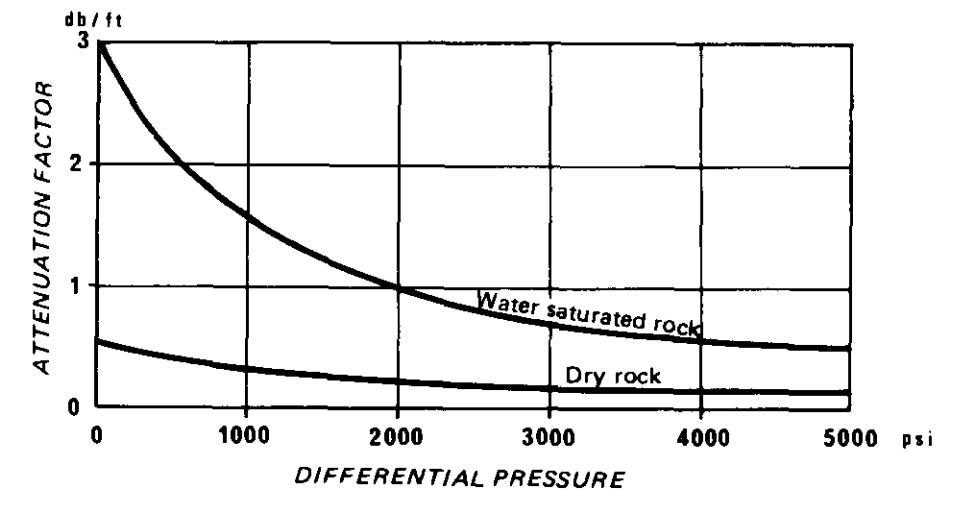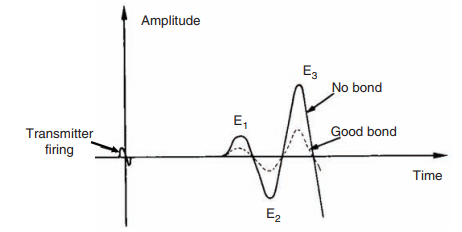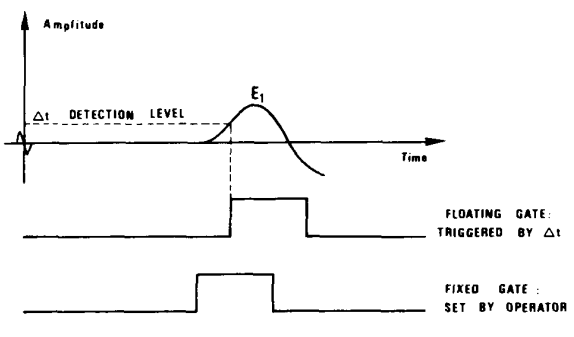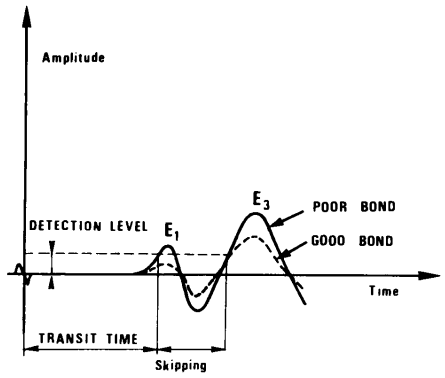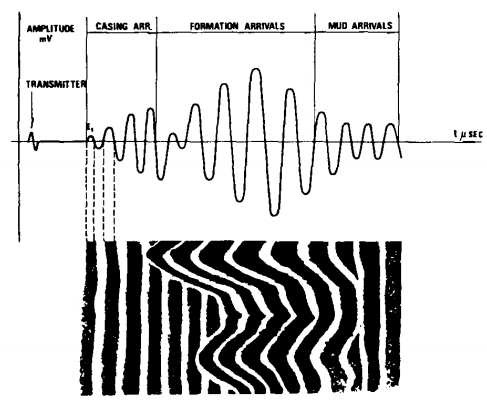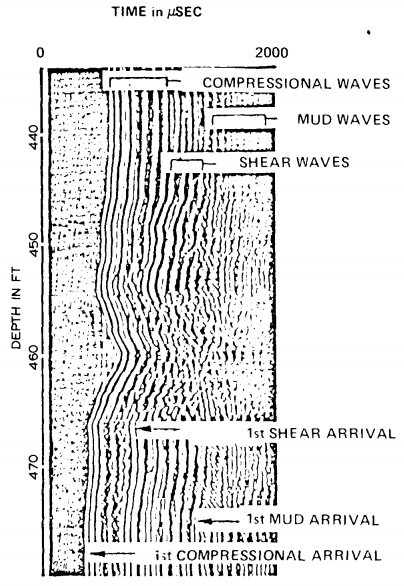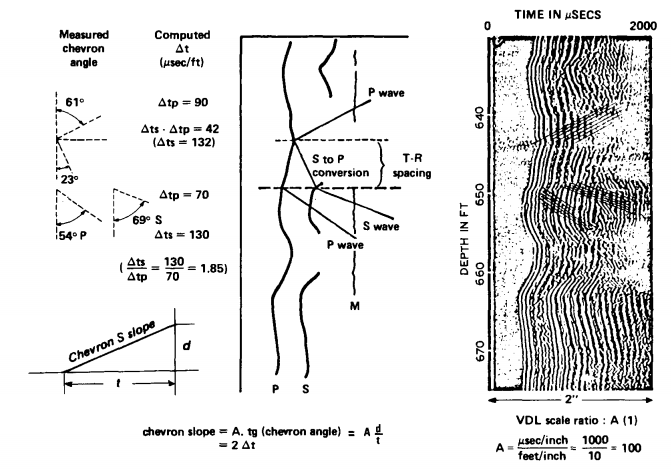The amplitude of an acoustic wave decreases as it propagates through a medium. This decrease is known as attenuation. It depends on several factors:
- The wavelength of the wave and its type (longitudinal or transversal).
- The texture of the rock (pore and grain size, type of grain contact, sorting), as well as the porosity, permeability and the specific surface of the rock pores.
- The type of fluid in the pores and in particular its viscosity.
- Rock fractures or fissures.
In cased wells the attenuation depends mainly on the quality of the cement around the casing. This can be indirectly measured by recording the sonic amplitude. This application is known as the Cement Bond Log (or CBL).
Different causes of attenuation
1. Loss of energy through heating
The vibration caused by the passage of a sonic wave causes energy loss in the form of heat. This loss of energy can have several interactions - Solid-to-solid friction, Solid-to-fluid friction or Fluid-to-fluid friction.
2. Redistribution of energy
The energy of the secondary wave comes from the primary wave and so a fraction of the original energy is transferred to the medium M2.
A transverse wave moving in the medium M1 also transfers part of its energy to M2 in the form of a compressional wave.
All this occurs in open hole along the borehole wall where the mud-formation boundary occurs and also in cased hole where the casing is not well cemented.
When the sonic wave encounters particles, whose dimensions are less than the wavelength, the sonic energy is dispersed in all directions, whatever is the shape of the reflection surface.
Different Attenuations happening in borehole
1. Open-hole
This is due the acoustic losses due to friction e.g., solid to fluid, and to dispersion losses at particles in suspension in the mud.
In a pure liquid this attenuation follows for one unique frequency:
$$\delta_{m}=e^{mx}$$
in which m is the attenuation factor in the liquid, proportional to the source of the frequency, and x is the distance over which the attenuation is measured.
For fresh water and at standard conditions of temperature and pressure, for a frequency of 20 kHz the attenuation factor is of the order of \(3\times 10^{-5}\) db/ft.
It is higher for salt water and oil.
It decreases
as the temperature and pressure increase.
For normal drilling muds which contain solid particles we have to add the effect of dispersion. It is estimated that the total dispersion is of the order of 0.03 db/ft for a frequency of 20 kHz.
In gas cut muds the attenuation caused by dispersion is very large, so making all sonic measurements impossible.
Note: Gas-cut mud: A drilling fluid (or mud) that has gas (air or natural gas) bubbles in it, resulting in a lower bulk, unpressurized density compared with a mud not cut by gas.
Attenuation by transmission of energy occurs at the mud-formation boundary for waves arriving at an angle of incidence less than critical.
(i) Frictional energy loss
In non-fractured rocks the attenuation of longitudinal and transverse waves is an exponential function of the form:
$$\delta_{F}=e^{al}$$
in which 'a' is the total attenuation factor due to different kinds of friction: solid to solid (a'), fluid to solid (a'') and fluid to fluid (a'''): a = a' + a'' + a'''
and l is the distance travelled by the wave. It is given by the equation:
$$l = L - (d_h - d_{tool})tgi_c$$
where L is the spacing, \(d_h\) and \(d_{tool}\), are the diameters of the hole and the tool, \(i_c\) is the critical angle of incidence, which goes down as the speed in the formation increases.
- When the rock is not porous, the factors a'' and a''' are zero.
- When the rock is water saturated, a''' = 0.
- In porous rocks, the attenuation factor a'' depends on the square of the frequency, whereas the factors a' and a''' are proportional to the frequency.
- The factor a'' depends equally on porosity and permeability. It increases as the porosity and permeability increase.
- The attenuation factors a' and a'' decrease as the differential pressure \(\Delta p\) (geostatic pressure - internal pressure of the interstitial fluids) increases.
- When the rock contains hydrocarbons a greater attenuation of the longitudinal wave is observed in the case of gas than for oil (the factor a''' non zero).
So, we can write that for a given tool considering all the different parameters acting on the attenuation:
$$a = F(f, v, \phi, k, S, \mu, \Delta p, \rho)$$
where,
\(f=\) frequency,
\(v=\) velocity of sound,
\(\phi=\) porosity,
\(k=\) permeability,
\(S=\) saturation,
\(\mu=\) viscosity of the fluids,
\(\Delta p=\) differential pressure and
\(\rho=\) density of the formation.
(ii) Loss of energy through dispersion and diffraction: this appears mainly in vuggy rocks.
When a formation is made up of laminations of thin beds of different lithology at each boundary some or all of the energy will be reflected according to the angle of incidence. This angle is dependent on the apparent dip of the beds relative to the direction of the sonic waves. In the case of fractured rocks the same kind of effect occurs with the coefficient of transmission as a function of the dip angle of the fracture with regard to the propagation direction.
There is another effect due to transfer of energy along the borehole wall this part is already explained above.
2. Cased hole
The attenuation is affected by the casing, the quality of the cement and the mud.
If the casing is free and surrounded by mud, it can vibrate freely. In this case, the transfer factor of energy to the formation is low and the signal at the receiver is high. In some cases, even when the casing is free we can see the formation arrivals (on the VDL). This can happen if the distance between the casing and the formation is small (nearer than one or two wavelengths), or when the casing is pushed against one side of the well but free on the other. Transmission to the formation is helped by the use of directional transmitters and receivers of wide frequency response.
If the casing is inside a cement sheath that is sufficiently regular and thick (at least one inch) and the cement is well bonded to the formation the casing is no longer free to vibrate. The amplitude of the casing vibrations is much smaller than when the casing is free and the transfer factor to the formation is much higher. How much energy is transferred to the formation depends on the thickness of the cement and the casing. As energy is transferred into the formation the receiver signal is, of course, smaller.
Between the two extremes, well bonded casing and free pipe the amount of energy transferred and hence the receiver signal will vary.
Measurement
Cement Bond Log
In the case of the Cement Bond Log (CBL), the general method is to measure the amplitude of the first arrival of the compressional wave at the receiver. These arrivals have a frequency between 20 and 25 kHz.
The amplitude of the first arrival is a function partly of the type of tool (particularly the tool spacing) and of the quality of the cementation: the nature of the cement and the percentage of the circumference of the tubing correctly bound to the formation.
As we have seen the amplitude is a minimum, and hence the attenuation a maximum, when the tool is in a zone where the casing is held in a sufficiently thick annulus of cement (one inch at least). The amplitude is largest when the casing is free.
Attenuation index
Law of attenuation in open hole
Variable density log (VDL)
- Strong amplitude of the compressional wave (E, or E2);
- weak or no P-chevron pattern;
- low amplitude of the shear waves; and
- well defined S-chevron pattern.
- low-amplitude P wave (E, and E2);
- little or no S-chevron patterns; and
- some P-chevron patterns.

